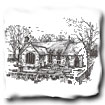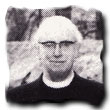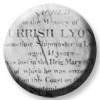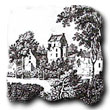The Auld Kirk of Cullen.
 The existence of a church at Cullen was first recorded in 1236, and again in 1275. It is likely that part of the present building dates back to this time, since the rounded arch window, originally a doorway, in the south west corner of the church indicates a building of early 13th century.
The existence of a church at Cullen was first recorded in 1236, and again in 1275. It is likely that part of the present building dates back to this time, since the rounded arch window, originally a doorway, in the south west corner of the church indicates a building of early 13th century.
In 1327, Queen Elizabeth de Burgh, second wife of Robert the Bruce, died at Cullen, and it is recorded that her 'interiores partes' were buried in the church. The king founded a chaplainry in that year to pray for her soul.
The church was dedicated to St. Mary the Virgin, the patron saint of Cullen. A carving of the Virgin and Child, now much weathered, may still be seen on the old Mercat Cross in Cullen Square. This same cross would once have stood outside the Kirk gates in the middle of the original Burgh of Cullen, which was demolished in the 1820's when the town was removed to its present position.
In 1536, John Duff of Moldovet founded a chaplainry of St. Anne, and in 1539 St. Anne's Aisle was completed on the south side of the church. The Church was elevated to the status of a Collegiate Church in 1543, one of a total of 38 throughout Scotland. These were maintained as centres of piety and learning in the pre- Reformation church, and in the case of Cullen a College was created consisting of a Provost, six Prebendaries and two singing boys, to ensure that the masses should be sung 'decently and in order every day'. The Sacrament House or Aumbry, a niche set into the north wall of the chancel near the site of the high altar, is decorated with intricate pre-Reformation carving. The Aumbry served as a receptacle for the reservation of the Blessed Sacrament.
Among other notable features inside the church are the tomb of Alexander Ogilvie of Findlater and Deskford (died 1554) and an imposing Laird's Loft, erected in 1602, around the time Sir Walter Ogilvie decided to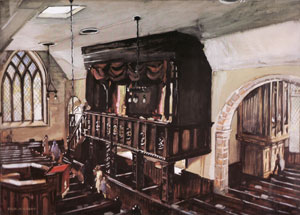 abandon the ancient Findlater Castle and bring his family seat up to Cullen. The loft and its supporting pillars are adorned by carved wooden panels which predate the loft itself. Prominent too is the monument to James, 4th Earl of Findlater and First Earl of Seafield, Lord High Chancellor of Scotland at the time of the Union of Parliaments in 1707. His notable statement, that the Union was 'the end o' an auld sang', encapsulated the feeling of melancholy at Scotland losing her long cherished national independence.
abandon the ancient Findlater Castle and bring his family seat up to Cullen. The loft and its supporting pillars are adorned by carved wooden panels which predate the loft itself. Prominent too is the monument to James, 4th Earl of Findlater and First Earl of Seafield, Lord High Chancellor of Scotland at the time of the Union of Parliaments in 1707. His notable statement, that the Union was 'the end o' an auld sang', encapsulated the feeling of melancholy at Scotland losing her long cherished national independence.
At the end of the 18th century, the North Transept was built, and afterwards galleries were added to the north and the west, giving the church its present-day proportions.
The churchyard contains a number of interesting old grave stones, carved with the traditional symbols of mortality.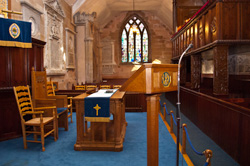 The Old Kirk has continued in use to the present time, services being held every Sunday morning, with fortnightly evening services in the Hall Church, Cullen for the convenience of local residents. The Old Kirk is a Category A listed building and is open for visitors at advertised times during the summer months, or by special arrangement on request.St. John's Church, Deskford: (Now in private ownership)
The old Parish of Deskford lies inland from Cullen and comprises extensive farmland as well as the hamlets of Berryhillock and Kirktown of Deskford.
The Old Kirk has continued in use to the present time, services being held every Sunday morning, with fortnightly evening services in the Hall Church, Cullen for the convenience of local residents. The Old Kirk is a Category A listed building and is open for visitors at advertised times during the summer months, or by special arrangement on request.St. John's Church, Deskford: (Now in private ownership)
The old Parish of Deskford lies inland from Cullen and comprises extensive farmland as well as the hamlets of Berryhillock and Kirktown of Deskford.
There is a record of an ancient chapel at Skeith, Deskford, dedicated to Our Lady of Pity, in which her wooden image was once preserved. For many centuries, however, the Parish Kirk dedicated to St. John the Evangelist was situated at Kirktown of Deskford within its churchyard.
.Now a roofless ruin in the care of Historic Scotland, it is of considerable historic interest, and is well worth a visit, particularly on account of its Sacrament House, or Aumbry, larger and more richly carved than that in Cullen Kirk, though in many ways similar and therefore probably by the same stonemason.
It was installed in 1551 by Alexander Ogilvy of Findlater and Deskford, and has an inscription in English as well as the usual Latin.
The Parish of Deskford was disjoined from the Parish of Fordyce in 1543, and the church at Kirkton, until that time the private chapel of the above Alexander Ogilvy, became the Parish Church.
The Parishes of Cullen and Deskford were linked in 1967, and then united in 1986 under one minister and Session. The church in use at present was opened in 1871, and is also known as St. John's Church.
It is the ruin which is signposted from the main Keith road, courtesy of Historic Scotland, although with its prominent position, the "new" church, itself a listed building, cannot be missed. The later church is of Victorian Gothic style, with large transept windows letting in plenty of light. That to the north incorporates unusual tracery detail. 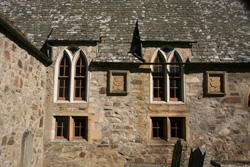 Two chancel windows are of stained glass and were installed in memory of the Rev. Dr. James Mackintosh, minister of Deskford, 1843 - 1902, and his wife. There is a gallery to the west, and the pulpit is built centrally into the organ casing on the east wall. A small sample of the original stencil work which decorated the entire church now remains on the east wall.
Two chancel windows are of stained glass and were installed in memory of the Rev. Dr. James Mackintosh, minister of Deskford, 1843 - 1902, and his wife. There is a gallery to the west, and the pulpit is built centrally into the organ casing on the east wall. A small sample of the original stencil work which decorated the entire church now remains on the east wall.
